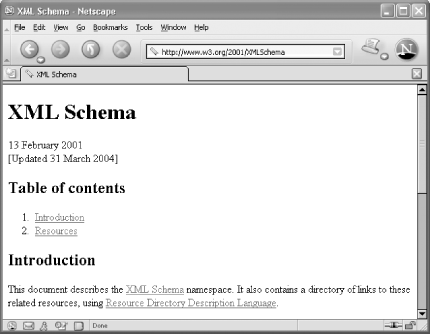 
RDDL is a XHTML language extension that can help dispel a confusion that surrounds XML namespaces, and let people find out more about your vocabularies. The Resource Directory Description Language or RDDL (http://www.rddl.org) was developed by members of the xml-dev mailing list (http://www.xml.org/xml/xmldev.shtml) in late 2000 and early 2001; Jonathan Borden and Tim Bray were the primary developers. It was created as one possible solution to the XML namespace problem, which is basically that an URI that uses a http:// scheme suggests that the URI is pointing at a resource, such as an actual document; however, this is not necessarily the case with XML namespaces, and so it creates confusion. RDDL provides a partial solution to this problem by providing a special document called a resource directory that can hold information about resources that are associated with a target namespace name. If you find XML namespaces a bit annoying, RDDL is a solution that can help. One of the main benefits of RDDL is that it's both human- and machine-readable. It uses XHTML so you can read it in a browser, and it also use XLink, whose special natures and purposes can help an application discover other resources. RDDL essentially extends the XHTML Basic module (http://www.w3.org/TR/xhtml-basic/) with a resource element. This element is allowed to contain mixed content [Hack #1] but chiefly it uses XML and XLink [Hack #28] attributes. Table 4-1 describes the attributes of the resource element, based on a DTD fragment in the RDDL spec (http://www.rddl.org/#resource). Table 4-1. Attributes of the RDDL resource element| RDDL attribute | Required? | Value description |
|---|
id
| optional | A unique identifier for the resource description. | xml:lang
| optional | A language token, such as en, de, fr, or es, for the resource description. | xml:base
| optional | The base URI for the resource description ( [Hack #28] ). | xmlns:rddl
| fixed | A namespace declaration for RDDL having a fixed value of http://www.rddl.org. | xlink:type
| fixed | The XLink type. Currently a fixed value of simple. | xlink:arcrole
| optional | A URI reference that is a machine-readable identifier for the purpose of this resource; for example, http://www.rddl.org/purposes/#schema-validation. For a list of possible purposes, see http://www.rddl.org/purposes/. | xlink:role
| defaulted | A URI reference that is a machine-readable identifier for the nature of this resource; defaults to http://www.rddl.org/#resource. For a list of possible natures, see http://www.rddl.org/natures/. | xlink:href
| optional | A URI reference to the resource related to the target. | xlink:title
| optional | A short, human-readable descriptive title for the resource. | xlink:embed
| fixed | Not used; value of none. | xlink:actuate
| fixed | Not used; value of none. |
More and more namespace names or URIs resolve to resource descriptions. For example, XML Schema's namespace URI (http://www.w3.org/2001/XMLSchema) resolves to such a resource description document. The source markup for this document follows in Example 4-3, and it is displayed in Figure 4-1. Example 4-3. xmlschema-rddl.html <?xml version='1.0'?> <!DOCTYPE html PUBLIC "-//XML-DEV//DTD XHTML RDDL 1.0//EN" "http://www.w3.org/2001/rddl /rddl-xhtml.dtd" > <html xmlns="http://www.w3.org/1999/xhtml" xmlns:xlink="http://www.w3.org/1999/xlink" xmlns:rddl="http://www.rddl.org/" xml:lang="en"> <head> <title>XML Schema</title> </head> <body> <h1>XML Schema</h1> <div > <p>13 February 2001<br/>[Updated 31 March 2004]</p> </div> <div > <h2>Table of contents</h2> <ol> <li><a href="#intro">Introduction</a></li> <li><a href="#related.resources">Resources</a></li> </ol> </div> <div > <h2>Introduction</h2> <p>This document describes the <a href="#xmlschemap1">XML Schema</a> namespace. It also contains a directory of links to these related resources, using <a href="http://www.rddl.org/">Resource Directory Description Language</a>.</p> </div> <div > <h2>Related Resources for XML Schema</h2> <!-- start resource definitions --> <h2>Schemas for XML Schema</h2> <div > <rddl:resource xlink:title="DTD for validation" xlink:arcrole="http://www.rddl.org/purposes#validation" xlink:role="http://www.isi.edu/ in-notes/iana/assignments/media-types/application/xml-dtd" xlink:href="XMLSchema.dtd"> <h3>DTD</h3> <p>A DTD <a href="XMLSchema.dtd">XMLSchema.dtd</a> for XML Schema. It incorporates an auxiliary DTD, <a href="datatypes.dtd">datatypes.dtd</a>.</p> </rddl:resource> </div> <rddl:resource xlink:title="XML Schema schema document" xlink:role="http://www.w3.org/2001/XMLSchema" xlink:arcrole=" http://www.rddl.org/purposes#schema-validation" xlink:href="XMLSchema.xsd"> <div > <h2>XML Schema</h2> <p>An <a href="XMLSchema.xsd">XML Schema schema document</a> for XML Schema schema documents. This corresponds to <a href="http://www.w3.org/TR/2004/PER-xmlschema-1-20040318/ #normative-schemaSchema">the version published in the Proposed Edited Recommendation</a> revision of XML Schema.</p> </div> </rddl:resource> </div> <div > <h2>Normative References</h2> <ol> <li> <rddl:resource xlink:title="W3C CR XML Schema Part 1" xlink:role="http://www.w3.org/TR/html4" xlink:arcrole=" http://www.rddl.org/purposes#normative-reference" xlink:href="http://www.w3.org/TR/2004/ PER-xmlschema-1-20040318/"> <a href="http://www.w3.org/TR/2004/PER-xmlschema-1-20040318/">XML Schema Part 1: Structures</a> (Proposed Edited Recommendation) </rddl:resource> </li> </ol> </div> </body> </html>
At the top of the document in Example 4-3, the document type declaration uses an RDDL DTD rather than an XHTML DTD. The bold portions of the XHTML markup show the resource elements prefixed with rddl, the attributes they have, and the mixed content they hold. For example, the first resource element uses the xlink:title, xlink:arcrole, xlink:role, and xlink:href attributes. The xlink:role attribute, with a value of http://www.isi.edu/in-notes/iana/assignments/media-types/application/xml-dtd, signifies that the document uses the application/xml-dtd media type (see http://www.ietf.org/rfc/rfc3023.txt). After the start tag, the resource element contains mixed-element and text content that describes the resource in human terms. Figure 4-1. Resource description of XML Schema in Netscape 
The RDDL spec also provides links for an RDDL DTD, grammars in RELAX (http://www.xml.gr.jp/relax/), RELAX NG (http://www.relaxng.org), and TREX (http://www.thaiopensource.com/trex/), a Schematron schema (http://xml.ascc.net/resource/schematron/schematron.html), and numerous other resources, including Java and C# APIs. You can use the document xmlschema-rddl.html as a model for creating your own RDDL document. 4.3.1 See Also Leigh Dodds' XML.com introduction to RDDL: http://xml.com/pub/a/2001/02/28/rddl.html Elliotte Rusty Harold's "RDDL Me This: What Does a Namespace URL Locate?": http://xml.oreilly.com/news/xmlnut2_0201.html There is a proposal out for RDDL 2.0, released in early 2004, which does not include XLink attributes: http://www.rddl.org/rddl2
|
